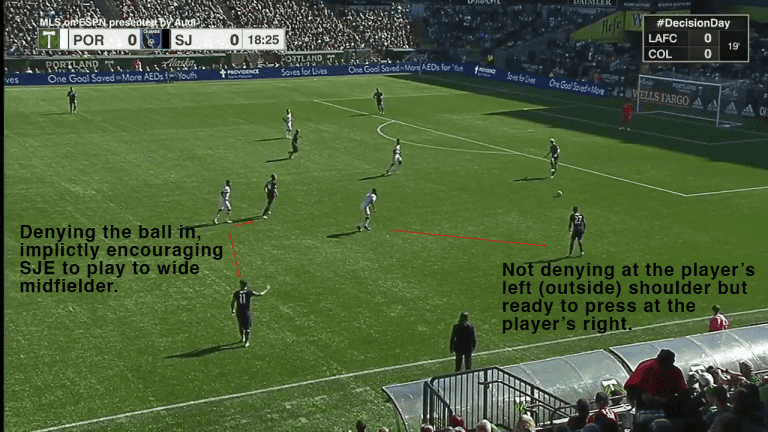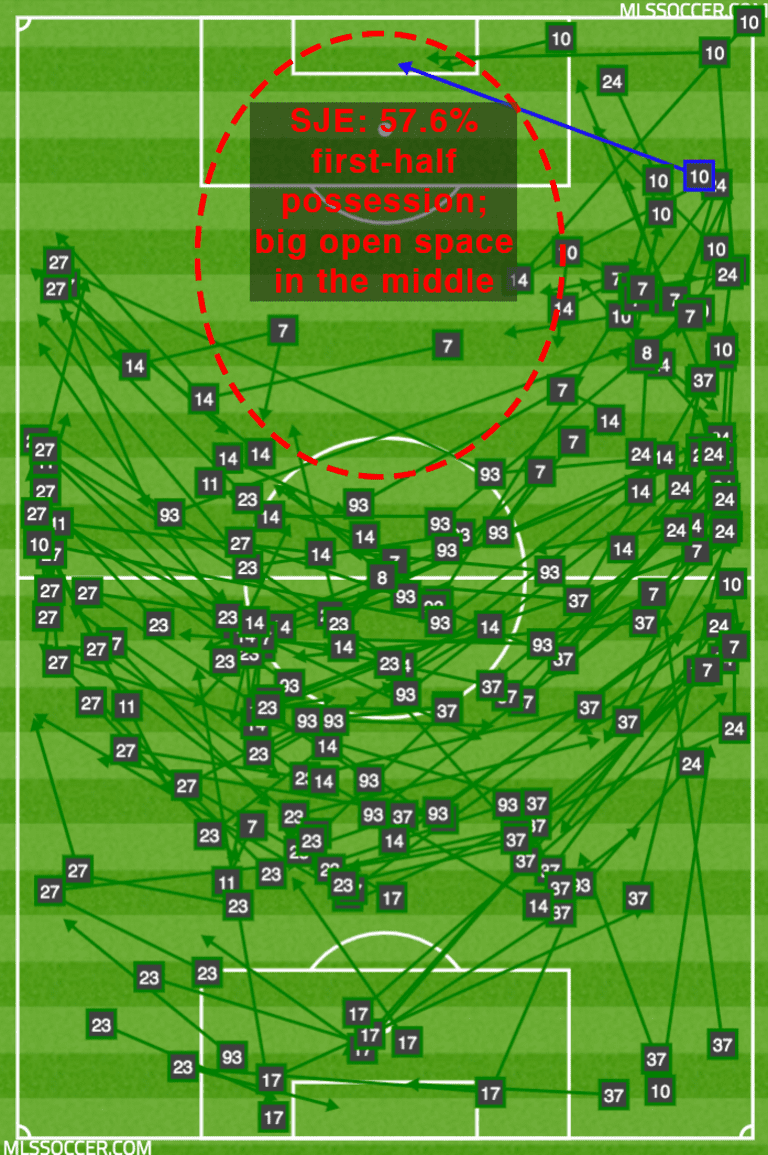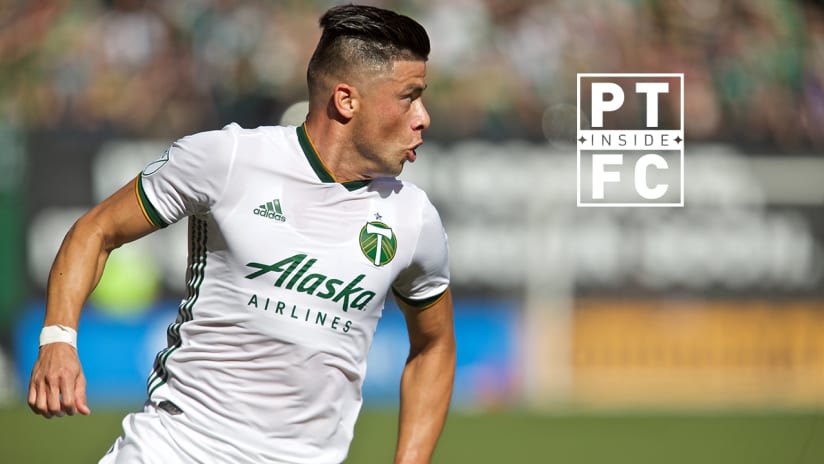PORTLAND, Ore. – His notes of influence were all over the Portland Timbers’ gameplan, but that was nothing new. For the team’s can’t-lose season finale on Sunday against the visiting San Jose Earthquakes, Portland head coach Giovanni Savarese and his staff had installed a defensive trap which, if it worked, would demand right back Jorge Moreira’s execution.
That's not uncommon for a fullback in high-level soccer, particularly for teams that want to press high up the field. As forwards push possession to the flanks and midfielders prevent passes from going back to the middle of the field, it's often the fullbacks, matched up against attacking players, who define the point of attack. When the other team's pressed, moved into certain zones, and deprived of other options, somebody has to win the ball. Often, that's the team's wide defenders.
On Sunday, San Jose was given slightly more room down their left. Once the ball was wide, Dairon Asprilla wasn't trying to push it backup field. He was giving the sideline. The midfielder behind him, Andy Polo, was preventing play from coming back in, which meant the fullback behind him, Moreira, would have to win the ball.
The shape could be seen early on …

… with the execution …
… producing a series of defensive actions for Moreira near the center line:

(First-half actions for Jorge Moreira against San Jose: yellow - possession recoveries; blue - interceptions; green - tackles.)
Over the full 90 minutes, Moreira’s seven tackles were more than twice as many as his closest teammate, left back Jorge Villafaña. Moreira’s two interceptions were also a team lead, and while the six times he recovered possession didn’t challenge for team best, four of those recoveries came in that crucial region near the middle of the field.
His performance was part of the reason why, although San Jose controlled possession (keeping the ball for 61.2 percent of the game, according to Opta), the Timbers controlled how the game was played. Chris Wondolowski, San Jose's lone striker, only touched the ball 17 times in 90 minutes. Vako, the `Quakes’ second-leading scorer, only had 33 touches, with a mere 13 turning into passes for his teammates. The San Jose players moving the ball most were deeper players, like defensive midfielders Jackson Yueill (66 passes) and Judson (58). Midfielder Magnus Eriksson dropped deeper as the game went on and ended up with 57 passes, but the next players on the Earthquakes’ list were defenders: center back Guram Kashia (53) and left back Marcos Lopez (41).

(San Jose's successful first-half passes on Sunday.)
Without the viewpoint of Portland’s coaches, it would be too much to imply Moreira was key to Sunday’s approach, and in the different ways the Timbers tried to force San Jose to give up the ball, other players had responsibilities that mirrored the Paraguayan. But in a year in which the early worries about Moreira’s arrival cited examples on the defensive side of the ball, it’s worth noting how the 29-year-old, on Sunday, contributed most.
Defense isn’t only about how you play close to your own goal, and while mistakes made there have the costliest outcomes, there are other parts of defending that contribute to your value. Moreira’s defending high in his own end and in San Jose’s part of the field was key to Portland pinning their opponents during the middle of Sunday’s first half.
For the season, his 4.1 tackles per 90 minutes are by far the most on the team, roughly 34 percent more than second-place Diego Chara. Only one person in Major League Soccer, San Jose’s Judson, has more successful tackles per 90 (given at least 1500 minutes played). Likewise, his 1.5 interceptions per 90 are also his team’s best rate. While numbers like these may only scratch the surface on a player’s defensive contributions, Moreira’s numbers at least speak to something positive.
Perhaps the most defining of Moreira’s surface features, though, is something more easily discernible – the effort which, renown when he was loaned to Portland from River Plate, has become a constant throughout his MLS debut campaign. During his time with one of Argentina’s giants, Moreira’s work became his defining trait, so much so that it’d become a personal point of pride. “You want to give everything to return the trust you have been given,” he told us this spring, when asked about his willingness to cover the entire right flank of the field.
That willingness has been on display since the first moments of his campaign, like in an early first-half sprint in the season’s second game, at the LA Galaxy, to defend a long cross. Still, the most famous example of Moreira’s effort would come later, once the Timbers finally returned home, when his run from his right-back position into attack found him at the left-edge of the Houston Dynamo’s six-yard box, ready to head a pass down for teammate Marvin Loría’s MLS-debut goal:
This is the more obvious way Moreira’s added to Portland’s arsenal: by being the next guy forward. Last season, with Alvas Powell and Zarek Valentin occupying the right back spot, the Timbers had different options, both of which were used during the 2018 playoffs. But as he became available this winter, Moreira presented Portland with the opportunity for something different – something that could significantly change how the team set up.
Although Powell could get forward into attack, his forays forward lacked the same persistence and opportunism of Moreira. The long-time Timbers player could break defenses when he surged forward, but those surges were exceptions, not rules. Moreira, on the other hand, defines himself by his ability to get into the attack and be accounted for. That’s allowed a player like Jeremy Ebobisse, a natural striker, to play right wing in the defensive phase and, when the team transitions, move back toward the middle of the field, being certain that Moreira will keep defenses accountable beyond the penalty box.
While Valentin’s technical quality has proven valuable in the attacking phase – allowing Savarese to add another holding player to midfield when the fullback comes in – Moreira provides a wide threat that's rare in Major League Soccer. Part of that is reflected in his 5.4 crosses per 90 minutes (third in MLS); part of that is reflected in the team’s tactics themselves. In all of the attacking, transition and defensive phases, the unique skills Moreira has brought to Portland have given the Timbers more options.
We saw the defensive aspect on Sunday – a can’t-lose game where Moreira’s first-half presence was definitional. We’ve seen him in transition before, as when he opened up space in Chicago’s back line by pulling a fullback wide with a run, …
… and, throughout the season, we’ve seen the options it has afforded Portland’s attack. Few fullbacks in the league offer their coaching staffs so many option. That Moreira’s options can make him a focal point of a plan at multiple levels of the field also makes him one of the most dynamic fullbacks in Major League Soccer.
Early, as his team got used to the spaces Moreira would attack and vacate, there were learning experiences, and there were times when Portland would need to provide cover. Sometimes, the team failed, making Moreira's integration more of a process than an immediate solution. Now, nine months into that integration, those lessons have been learned. Ahead of his first playoff game with the Timbers, Moreira’s made Portland’s right back position his own.












